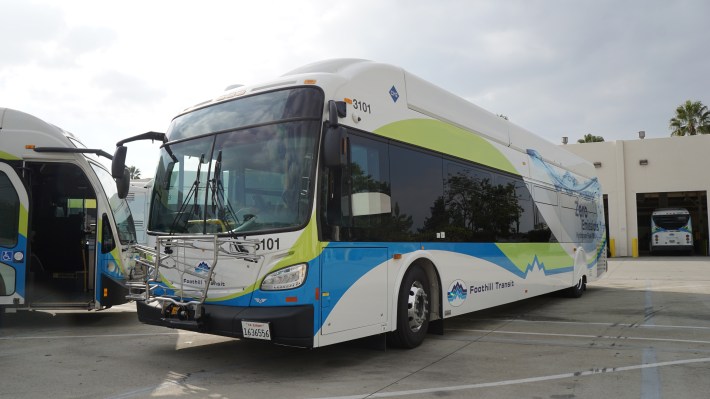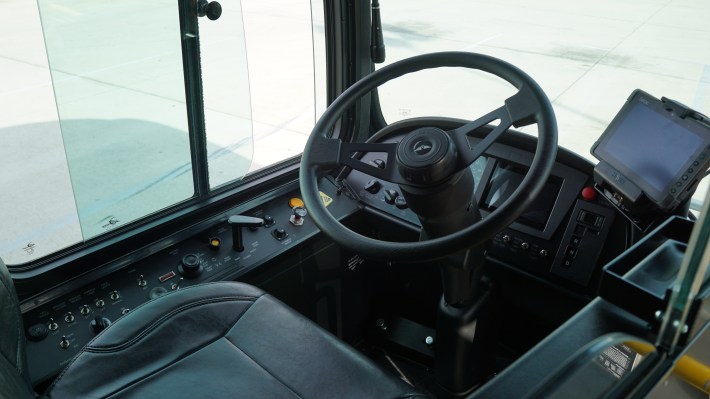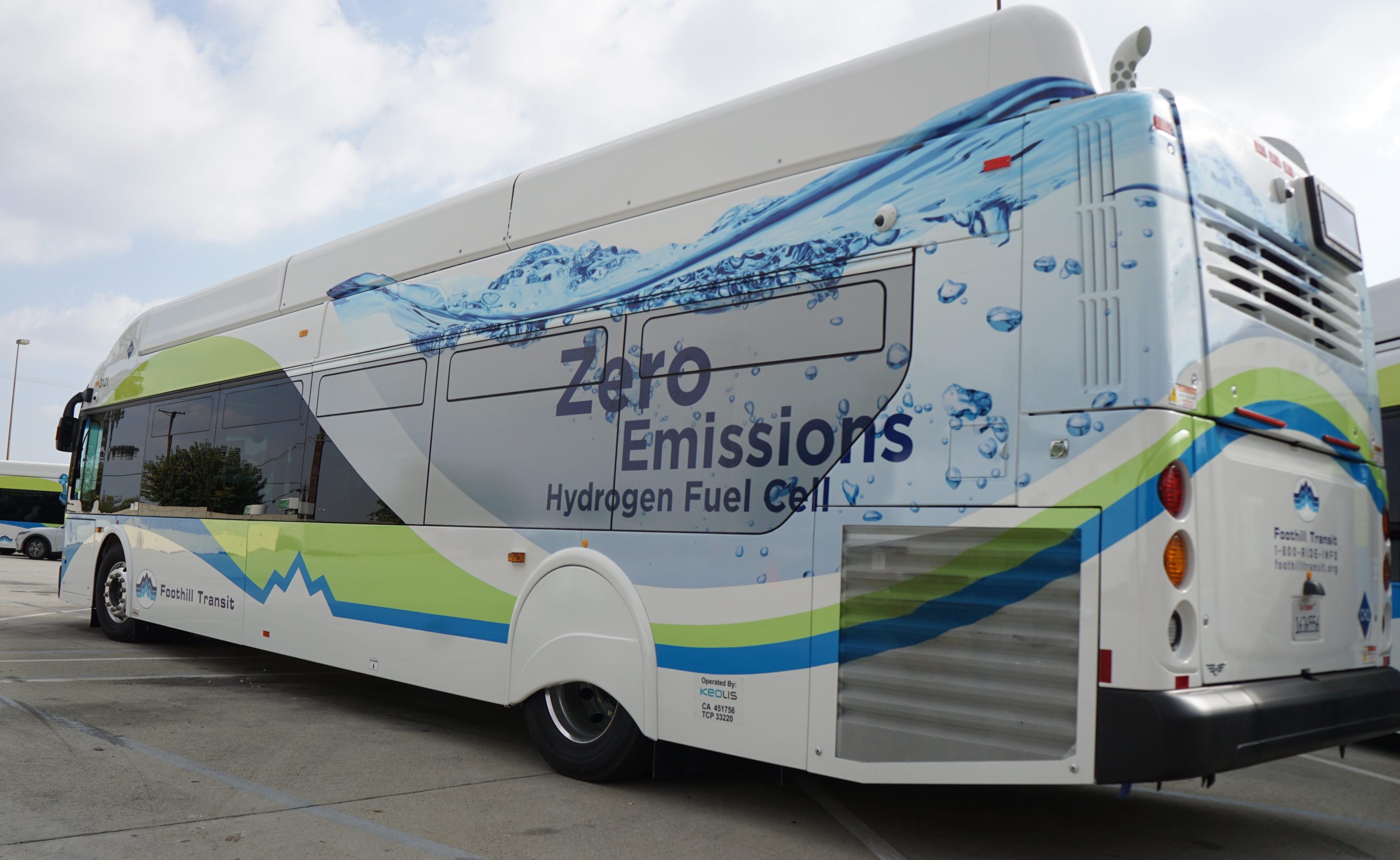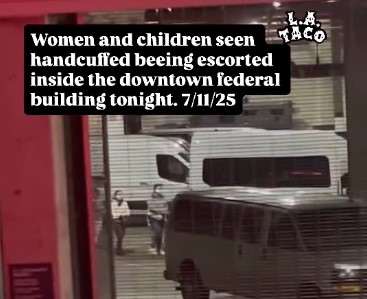Foothill Transit will debut its new Hydrogen Fuel Cell powered bus fleet on Monday, with three HFC buses running on Line 291 from Pomona to La Verne. Foothill has ordered a total of 33 buses from New Flyer, and installed a 25,000 gallon hydrogen fueling tank at the agency’s Pomona yard to be commissioned in February 2023.
These rear-wheel drive, hydrogen buses will replace battery electric buses from Proterra, according to management. Foothill Transit spokesperson Felicia Friesema says at this time the only types of buses Foothill plans to purchase are HFC’s and traditional CNG’s (Compressed Natural Gas). She says the Proterras generally take hours to charge, and get about 125 to 150 miles of range.
“So with the hydrogen fuel cell, it more closely fits the logistics of a CNG bus because you're fueling it the same way you do a CNG bus [with a pump], but it has a 300 mile range, and the CNG's are 350, 360,” says Friesema. “So you've got a bus that has a comparable mileage range, and you've got the same kind of fueling profile where it only takes a few minutes, 10 minutes to fuel a hydrogen bus. And so you don't have to keep a bus out of service for hours in order to get it fully charged back up into service.”
Jeffrey Moore, Assistant General Manager for the Foothill Transit Pomona Operations and Maintenance Facility, believes the HFC’s will be more cost effective in the long run. “The Proterras were a bear to keep in service. We had a lot of technical issues with them,” says Moore. “So these seem to be a lot more streamlined in that respect for maintenance. And they ride better.”
How's that?
“[They] feel a lot smoother, they're bigger, they accelerate better. And they’re just all around – again we haven't put them in complete full service, but just ride them around the yard, getting the drivers’ opinion – we think they're a much better piece of equipment.”





When SBLA visited the yard, there was a familiarization training going on for drivers. Coach Operator Mark Bangs said, “I want to go home with it, park it in my driveway, it ran so smooth.”
Training Manager Robert Anaya says there’s one key feature for operators on the New Flyer HFC’s that no other bus in Foothill’s fleet has: brake interlock.
“When it comes to a complete stop, three seconds after the bus comes to a complete stop, you're gonna feel the brake pedal drop. That's the interlock being activated by the bus. So the driver could actually take their foot off the brake, and the bus ain't gonna move. It's like having the parking brake on. So all you have to do to release it, hit the accelerator, and the bus goes.”
So how’s the Hydrogen Fuel Cell Work? Keith Malone, spokesperson for Hydrogen Fuel Cell Partnership, explains in lay terms.
“You're going to fill up in about the same [amount of] time as you do with a comparable fossil fuel vehicle. Once you're done, you're going to make your electricity on board inside those fuel cells. So with a battery electric, you're going to plug in and get your electricity from wherever you got it. But on board the [HFC] vehicle, we're going to inject that hydrogen from the tank. We're also going to inject oxygen from the air. We grab it, we filter it, and because those two molecules are highly attracted to each other, the fuel cells are designed to take advantage of that attraction. That creates a very powerful electrical current. At the same time, you have a battery (or batteries) on board these vehicles that capture any excess energy from the fuel cells or the regenerative braking systems. And in some cases, that battery helps even out the flow of electricity to the motor [...] In some cases, we have what we might call buses that are fuel cell dominant or battery dominant. In some cases the fuel cells help replenish the battery. And so the battery serves as the dominant source of electricity, and the fuel cells in a way tend to be almost like range extenders.”
Friesema says the the only exhaust is water vapor, and heat from the Fuel Cell’s chemical reaction is used to heat the New Flyer HFC buses in Winter. Despite these benefits, the hydrogen supply will still have a carbon footprint though: its sources will be 33 percent renewable, and 67 percent from fossil fuels.
The California Air Resources Board has mandated through its Innovate Clean Transit Regulation that, by 2023, 25 percent of all new bus purchases are zero emissions. These purchase percentages go up to 50 percent in 2026, and 100 percent in 2029. By 2040, 100 percent of all buses in fleets must be zero emission vehicles.
These HFC buses are costly though. Foothill is paying $1.2 million per bus, compared to $859,000 per CNG bus, and $950,000 per BEB. The cost per mile for fuel is $1.00 for HFC, $0.35 for CNG, and $0.45 for BEB.
Foothill Transit has received $5 million in funding from the state’s Transit and Intercity Rail Capital Program (TIRCP), $8.9 million from the state’s Hybrid and Zero-Emission Truck and Bus Voucher Incentive Program (HVIP), and more money from FTA grants (Section 5307).
All 33 New Flyer buses are to be delivered to Foothill Transit by December 20, 2022 and will be added among various bus lines as they pass acceptance and DMV registration. The next route they’ll be worked into will be Line 486, from El Monte to Pomona.
As to whether Foothill Transit has plans to purchase more of them, spokesperson Felicia Friesema says, they'll soon get to know what these buses are like for real, starting Monday (she says Line 291 is a "workhorse line" with heavily used stops: a medical center, a library, and schools).
"Our hopes are high. Based on the initial research we did, it looks really promising as a truly viable way to have zero emissions fleet vehicles out on the road and in service. And if they do well, we'll get more. And if we find challenges or things that we have to work around, we're going to share best practices with our other transit partners and we're going to keep looking for newer technologies.”
Streetsblog’s San Gabriel Valley coverage is supported by Foothill Transit, offering car-free travel throughout the San Gabriel Valley with connections to the Gold Line Stations across the Foothills and Commuter Express lines traveling into the heart of downtown L.A. To plan your trip, visit Foothill Transit. “Foothill Transit. Going Good Places.”
Sign-up for our SGV Connect Newsletter, coming to your inbox on Fridays!







